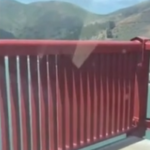 A golden opportunity for source noise control
A golden opportunity for source noise control
Recent news reports describe how the Golden Gate Bridge now “sings” in high winds. It all started after the recent installation of railings intended to improve airflow across the bridge, making it the world’s largest unintentional Aeolian Harp. Posted videos indicate the howling can be plainly audible at Land’s End (2.6 miles away) and can be excruciating while on the bridge itself. Reports suggest that the tones were noticed during wind tunnel testing but, as often happens, the acoustic consequences were a big surprise.
This situation is analogous to many challenges related to noisy products and machines that I’ve helped solve. A design change creates a noisy situation, and returning to the original configuration is out of the question. Now what?
A source noise control project to improve the Bridge would entail figuring out:
- why the bridge makes a noise in the first place,
- which parts of the bridge participate in the noisemaking, and
- how to alter the bridge to reduce the efficiency of conversion of wind power to sound.
Conventional noise control involving earplugs, noise barriers on the bridge or on land, or sophisticated active noise cancellation systems, are likely to be impractical, ugly, expensive, or subject to deterioration by sun, moisture, and wind. Source noise control is clearly the desired approach here.
1. WHY
Noise is generated when strong wind blows over the new railings. Turbulent vortices that shed downstream apply an oscillating force to the railings.
The frequency of oscillation is a function of the wind speed divided by the railing diameter. So you’d expect the bridge to sound like a giant slide whistle, the tone moaning up and down with the wind speed. But that’s not what we hear: clearly defined pitches come and go but their pitch remains pretty consistent. This indicates that the bridge is responding at resonant frequencies, as if the wind is bowing a zillion violin strings.
Analysis of the audio from one video reveals three tones that are related in a musical way. The loudest tone is actually 440 Hz, otherwise known as A440: a cheerful coincidence, a giant tuning fork, too!. Next in importance is 552 Hz, the “C” note a minor third above A440. The frequency ratio corresponding to a (natural) minor third is 6:5. In between these tones there’s a kind of flat-ish “B” note at 484 Hz.
These are all members of a harmonic series, like harmonics on a guitar string. In fact, the three tones correspond closely to the 10th, 11th, and 12th harmonics of something that has a fundamental resonance of 44 Hz.
Nerding out briefly:
- Back-of-the-envelope estimates suggest that the railings convert “only” about 10 parts per million of the wind energy to sound. However there’s so much wind energy that the bridge produces something like 200W of acoustic power, roughly equivalent to a 12,500W sound system. So it’s like a Brian Eno concert on the bridge. How cool is that!
- When you stand near the railings, my estimates suggest sound levels well above 90 dBA. Definitely in the “excruciating” range without earplugs.
2. WHICH
 For the reported windspeeds, and guessing the dimensions of the bridge railings, it’s most likely that the vertical railings are driving the vibrations. That doesn’t necessarily mean they are the sound-radiating elements; the horizontal rails or some pre-existing portion of the bridge could also serve that function. Anyway, the 44 Hz fundamental resonance is really low, suggesting a really long, heavy “bass string”. That’s more likely to be the horizontal rails rather than the vertical ones. Pre-existing portions of the bridge are less likely candidates (long explanation), but can’t be ruled out.
For the reported windspeeds, and guessing the dimensions of the bridge railings, it’s most likely that the vertical railings are driving the vibrations. That doesn’t necessarily mean they are the sound-radiating elements; the horizontal rails or some pre-existing portion of the bridge could also serve that function. Anyway, the 44 Hz fundamental resonance is really low, suggesting a really long, heavy “bass string”. That’s more likely to be the horizontal rails rather than the vertical ones. Pre-existing portions of the bridge are less likely candidates (long explanation), but can’t be ruled out.
The sound-radiating element could be identified onsite through measurement on a windy day, or by “thumping” with a rubber mallet on a quiet day. Alternatively, with enough dimensional information, likely candidates can be determined from afar through calculation.
3. HOW
Obviously there are new “driving” elements converting wind to vibration, and new “driven” elements converting vibration into sound. Both must be present for this problem to occur. Source noise control involves addressing one or the other (or both), and/or decoupling them from one another. Practical concepts include changing:
- the excitation frequency by changing the dimensions of the railing elements that “drive” the system.
- the excitation amplitude by modifying the aerodynamic profile of the driving elements, or by de-correlating (confusing) the forces along their length.
- the response frequency of the sound-radiating elements of the bridge by altering mass and/or stiffness.
- the response magnitude by adding mechanical damping.
- the way the driving and driven elements attach.
Specific recommendations require more information, of course. But one striking characteristic of source noise control solutions is that they often use no “noise control materials” at all.
CONCLUSION
This is how we do source noise control, often as in this case with little to no data or information.
Unique skills, awareness, and real-world experience are the actual “magic” of noise control.
Part of the art behind the science is being confident we’re fixing the right elements, and that the fix doesn’t create a new problem that’s even worse.
Another aspect is knowing how much better is “good enough”. Because total silence is an unlikely outcome, it’s necessary to understand the connections between sound level, sound characteristics, annoyance, and the cost of achieving different levels of reduction.
Meanwhile, it’s critical to avoid prevalent misconceptions about sound levels, perceived improvement, and how they are reported. See the series on Myths, Misunderstandings, and Magical Thinking about Noise…..
3. Careful with that dB Thermometer
4. The Forbidden Word – Soundproof
6. “Wait-and-See” Noise Control: Why Bet the Farm?
7. Active Noise Cancellation in the 21st Century
Copyright 2020 Nelson Acoustics
